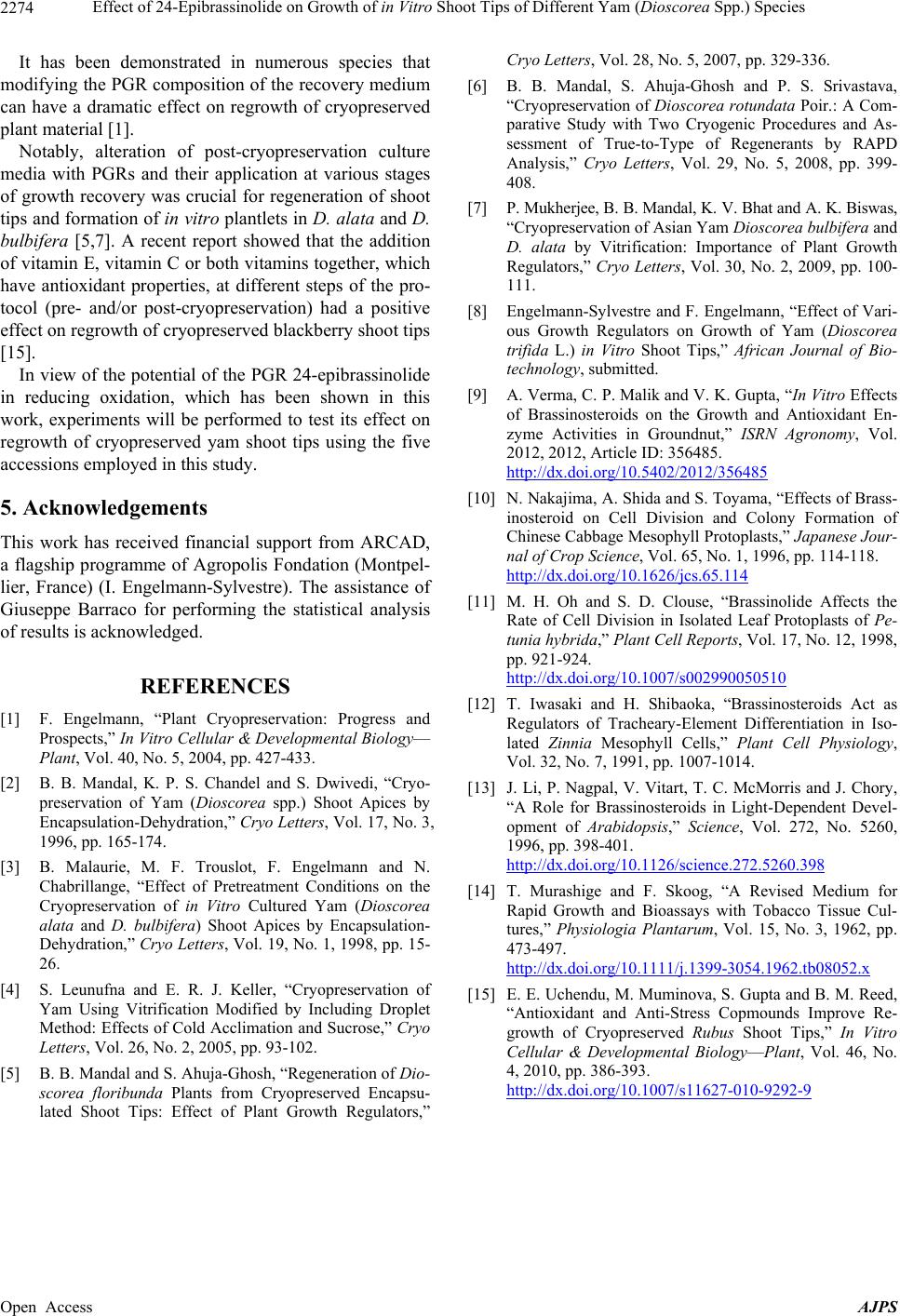
Effect of 24-Epibrassinolide on Growth of in Vitro Shoot Tips of Different Yam (Dioscorea Spp.) Species
2274
It has been demonstrated in numerous species that
modifying the PGR composition of the recovery medium
can have a dramatic effect on regrowth of cryopreserved
plant material [1].
Notably, alteration of post-cryopreservation culture
media with PGRs and their application at various stages
of growth recovery was crucial for regeneration of shoot
tips and formation of in vitro plantlets in D. alata and D.
bulbifera [5,7]. A recent report showed that the addition
of vitamin E, vitamin C or both vitamins together, which
have antioxidant properties, at different steps of the pro-
tocol (pre- and/or post-cryopreservation) had a positive
effect on regrowth of cryopreserved blackberry shoot tips
[15].
In view of the potential of the PGR 24-epibrassinolide
in reducing oxidation, which has been shown in this
work, experiments will be performed to test its effect on
regrowth of cryopreserved yam shoot tips using the five
accessions employed in this study.
5. Acknowledgements
This work has received financial support from ARCAD,
a flagship programme of Agropolis Fondation (Montpel-
lier, France) (I. Engelmann-Sylvestre). The assistance of
Giuseppe Barraco for performing the statistical analysis
of results is acknowledged.
REFERENCES
[1] F. Engelmann, “Plant Cryopreservation: Progress and
Prospects,” In Vitro Cellular & Developmental Biology—
Plant, Vol. 40, No. 5, 2004, pp. 427-433.
[2] B. B. Mandal, K. P. S. Chandel and S. Dwivedi, “Cryo-
preservation of Yam (Dioscorea spp.) Shoot Apices by
Encapsulation-Dehydration,” Cryo Letters, Vol. 17, No. 3,
1996, pp. 165-174.
[3] B. Malaurie, M. F. Trouslot, F. Engelmann and N.
Chabrillange, “Effect of Pretreatment Conditions on the
Cryopreservation of in Vitro Cultured Yam (Dioscorea
alata and D. bulbifera) Shoot Apices by Encapsulation-
Dehydration,” Cryo Letters, Vol. 19, No. 1, 1998, pp. 15-
26.
[4] S. Leunufna and E. R. J. Keller, “Cryopreservation of
Yam Using Vitrification Modified by Including Droplet
Method: Effects of Cold Acclimation and Sucrose,” Cryo
Letters, Vol. 26, No. 2, 2005, pp. 93-102.
[5] B. B. Mandal and S. Ahuja-Ghosh, “Regeneration of Dio-
scorea floribunda Plants from Cryopreserved Encapsu-
lated Shoot Tips: Effect of Plant Growth Regulators,”
Cryo Letters, Vol. 28, No. 5, 2007, pp. 329-336.
[6] B. B. Mandal, S. Ahuja-Ghosh and P. S. Srivastava,
“Cryopreservation of Dioscorea rotundata Poir.: A Com-
parative Study with Two Cryogenic Procedures and As-
sessment of True-to-Type of Regenerants by RAPD
Analysis,” Cryo Letters, Vol. 29, No. 5, 2008, pp. 399-
408.
[7] P. Mukherjee, B. B. Mandal, K. V. Bhat and A. K. Biswas,
“Cryopreservation of Asian Yam Dioscorea bulbifera and
D. alata by Vitrification: Importance of Plant Growth
Regulators,” Cryo Letters, Vol. 30, No. 2, 2009, pp. 100-
111.
[8] Engelmann-Sylvestre and F. Engelmann, “Effect of Vari-
ous Growth Regulators on Growth of Yam (Dioscorea
trifida L.) in Vitro Shoot Tips,” African Journal of Bio-
technology, submitted.
[9] A. Verma, C. P. Malik and V. K. Gupta, “In Vitro Effects
of Brassinosteroids on the Growth and Antioxidant En-
zyme Activities in Groundnut,” ISRN Agronomy, Vol.
2012, 2012, Article ID: 356485.
http://dx.doi.org/10.5402/2012/356485
[10] N. Nakajima, A. Shida and S. Toyama, “Effects of Brass-
inosteroid on Cell Division and Colony Formation of
Chinese Cabbage Mesophyll Protoplasts,” Japanese Jour-
nal of Crop Science, Vol. 65, No. 1, 1996, pp. 114-118.
http://dx.doi.org/10.1626/jcs.65.114
[11] M. H. Oh and S. D. Clouse, “Brassinolide Affects the
Rate of Cell Division in Isolated Leaf Protoplasts of Pe-
tunia hybrida,” Plant Cell Reports, Vol. 17, No. 12, 1998,
pp. 921-924.
http://dx.doi.org/10.1007/s002990050510
[12] T. Iwasaki and H. Shibaoka, “Brassinosteroids Act as
Regulators of Tracheary-Element Differentiation in Iso-
lated Zinnia Mesophyll Cells,” Plant Cell Physiology,
Vol. 32, No. 7, 1991, pp. 1007-1014.
[13] J. Li, P. Nagpal, V. Vitart, T. C. McMorris and J. Chory,
“A Role for Brassinosteroids in Light-Dependent Devel-
opment of Arabidopsis,” Science, Vol. 272, No. 5260,
1996, pp. 398-401.
http://dx.doi.org/10.1126/science.272.5260.398
[14] T. Murashige and F. Skoog, “A Revised Medium for
Rapid Growth and Bioassays with Tobacco Tissue Cul-
tures,” Physiologia Plantarum, Vol. 15, No. 3, 1962, pp.
473-497.
http://dx.doi.org/10.1111/j.1399-3054.1962.tb08052.x
[15] E. E. Uchendu, M. Muminova, S. Gupta and B. M. Reed,
“Antioxidant and Anti-Stress Copmounds Improve Re-
growth of Cryopreserved Rubus Shoot Tips,” In Vitro
Cellular & Developmental Biology—Plant, Vol. 46, No.
4, 2010, pp. 386-393.
http://dx.doi.org/10.1007/s11627-010-9292-9
Open Access AJPS